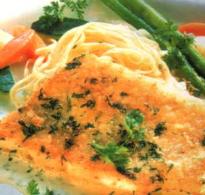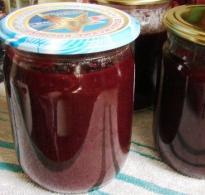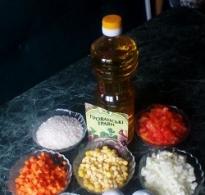Dishes of Norwegian cuisine. What is the national cuisine, traditional dishes and food in Norway? What products to bring from Norway
Norwegian cuisine is a delight for fish gourmets. After all, Scandinavian chefs create real miracles with fish. However, for everyone else there is a dish to taste. Let's find out how rich the national cuisine of Norway is.
Herring in apples

And all kinds of Norwegian snacks are full and rarely do without your favorite herring. We clean two small herrings and cut into medium-sized pieces. 1 head of red onion cut into half rings. Cut a couple of medium apples and 1 pickle. We combine all the ingredients in a salad bowl and season them with a sauce of 2 tbsp. l. vegetable oil, 1 tbsp. l. mustard and 1 tsp. 3% vinegar. At the end, we decorate the dish with slices of boiled eggs and herbs. By the way, for a festive family dinner, you can serve such a salad in the form of tarts.
brutal cheese

Speaking of appetizers, one cannot fail to mention the famous Norwegian cheese brunost. To prepare it, take 1.5 liters of fresh curd whey. If it is old, the cheese will turn sour. Boil down the whey to 500 ml, stirring it continuously with a wooden spatula. Add 250 ml of heavy cream, 2 tbsp. l. butter and cook until thickened. The mass should turn brown. The longer we torment it, the richer the color will be. We beat the cheese mass with a blender, fill it with silicone molds and put it in the refrigerator. The cheese will be firm but pliable. We cut it into thin slices, put it on crispbread and treat your loved ones.
northern salmon

Norwegian salmon in the homeland is eaten in any form. We offer to cook gravlax - pickled salted salmon. Cut a fillet weighing 1 kg in half, grease with 2 tbsp. l. cognac and olive oil. We chop a bunch of dill, add lemon zest, black pepper to taste and 2 tbsp. l. sea salt. We spread this mixture between two pieces of fillet and wrap in foil. We put this "sandwich" under the press in the refrigerator for 12 hours. Then we change the pieces of fish in places and marinate for another 12 hours. Wet the cooked salmon with a napkin and cut into slices. For a special treat for gourmets, serve a sauce of 2 tbsp. l. Dijon mustard, 1 tsp. sugar, 2 tbsp. l. oils and 1 tsp. wine vinegar.
Captivating salmon

Another fish hit is Norwegian salmon soup. We make the usual frying of onions and medium carrots. Scald 4 tomatoes with boiling water, remove the skin, cut the pulp into cubes and add to the frying. Simmer the vegetables for 3 minutes, pour 1⅓ l of water over them and add 4 diced potatoes. The mixture should boil for 10 minutes, after which 400 g of salmon, also diced, can be added. Following it, pour in 500 ml of warmed 20% cream and cook the soup for another 5 minutes. It remains to sprinkle it with chopped dill and let it brew under the lid for 20 minutes. You don’t have to call household members to the table - they will be led by a unique aroma.
Sailor's Joy

Despite the boundless love of the Scandinavians for Norwegian fish, meat dishes did not go unnoticed. A vivid example of this is sjemansbiff, he is meat in a naval way. Cut the beef pulp weighing 400 g into portions, beat off, grease with mustard and fry on both sides. We brown 2 onions in half rings and 4 potatoes in cubes in 90 g of bacon. We put the beef on the bottom of clay pots and cover with vegetables. Don't forget to season each layer with salt and pepper. Fill the filling with 400 ml of meat broth, cover the pots with lids and simmer for 30 minutes. In this form, we will serve the meat to the table to the delight of domestic meat-eaters.
Lamb in the bush

Lamb often appears in Norwegian recipes. One of the signature dishes is lamb with cabbage. Coarsely chop 500 g of meat (if the meat is on the bone, then use it with it), fry until golden brown in butter, pour in ½ cup of water, salt and pepper, simmer until almost cooked. We take out the meat and stew 1 kg of coarsely chopped cabbage in the same pan. Then we shift it with lamb into a heat-resistant form. Mix the juice in a pan with 40 g of flour, add a pinch of salt and pepper. Simmer the sauce until thick and pour lamb with cabbage over it. We bake the dish for 20 minutes at a temperature of 180 ° C. For the hungriest households, you can supplement it with boiled potatoes.
Sweet intricacies

National dishes of Norway cannot be imagined without. Mix 50 ml of milk, 1 tsp. sugar, 1 tsp yeast, let it rise. Separately, we combine 600 g of flour, 200 ml of milk, 80 g of sugar, an egg and ½ tsp. ground cloves. We introduce the approached yeast into the mass, 60 g of butter and knead the dough. For the filling, mix 60 g of butter, 3 tbsp. l. sugar and 2 tbsp. l. cinnamon. We roll out the dough into a layer, grease half with the filling and cover with the second half. We cut the layer into strips of 3 cm, twist them into flagella and make a semblance of knots. Place the buns on a baking sheet and bake for 20 minutes at 200°C. Complete the delicacy with berry juice, and the children will gobble it up in no time.
We hope that you and your loved ones will like these dishes, and some of them will add to the collection of selected recipes. Bright tasty discoveries and bon appetit!
Breakfast
A standard Norwegian breakfast in hotels usually consists of different types of bread, toasted bread slices, eggs, pickled herring, cheese slices and vegetable salads. Tea may be offered, but usually coffee is preferred at any time of the day in Norway.
Lunch
The most common food offered at unsi (lunch) is smörbrød (open sandwich) with ham, egg mayonnaise, herring, or sardines as common toppings.
Dinner
The main meal of the day is middag (evening meal), which you will most likely be served in any restaurant, unless of course you prefer the option of making your own. The Norwegian menu is dominated by fish and seafood. Meat is more expensive, however, at least once, we recommend that you try venison. Among the most commonly found vegetables are potatoes and cabbage.
special dishes
When it comes to fish, turrfisk (dried cod), sild (pickled herring) and gravlax (raw salmon marinated in dill brandy) are Norwegian delicacies. Fresh shrimp (re-ker) and fish soup (fiskesuppe) are always on the menu. Lu-tefisk, a type of dried cod, is usually served at Christmas.
Norway produces many types of cheeses, of which Jarlsberg is considered the most famous in the world. Don't miss the chance to try Gudbrandedalsost, a type of sweet sheep's cheese. Traditional Norwegian bread is called lefse and is somewhat reminiscent of pancakes. It is baked in a pan with a handle, but is now eaten less than in the past. Norwegians seem to prefer biscuits or crispbread as light snacks, so almost every place you eat will serve you one of their varieties, the flatbread.
A special pudding offered primarily in the north is römmegröt (porridge with cream), and a unique berry served here is molteber (cloudberry).
The drinks
Among the drinks in Norway, the most popular light beer is the "lager" type, which is brewed in the German style, although the national alcoholic drink is considered to be aquavit, made from potatoes and then flavored with herbs, most often cumin, dill and coriander. Wine is served in restaurants, it can also be bought in specialty shops.
Wines that are sold in France or Italy for a couple of euros can cost more than 10 euros in Norway. By law, the sale of beer and wine is allowed to persons over the age of 18, and stronger drinks - 20 years.
Vegetarianism
Unless you're into fish or seafood, the options for vegetarianism in Norway are quite limited and mostly boil down to salads, scrambled eggs and cheese. However, in larger cities there are ethnic restaurants, such as Indian or Chinese, where the choice of vegetables is much wider.
Norwegians are known to be the healthiest nation in the world. What do they eat in Norwayto maintain good health? invites you to taste the most famous Norwegian cuisine.
Lutefisk - dried cod soaked in lye
Norwegians eat a lot of fish, especially salmon and cod. In Norway, there are many recipes for cooking fish, but one of the most interesting is ram soaked in alkali. It can be a sea pike, but cod is most often used to make lutefisk. After the cod is soaked in a solution of caustic soda for three days, and then soaked in ordinary water for a few more days, it is boiled, fried in a pan or baked in the oven. It turns out a kind of fish jelly with a pungent smell and a bitter taste - Norwegian lutefisk. "Alkaline fish" is served with boiled potatoes, mashed peas and bacon. In Norway, lutefisk is considered a Christmas dish and certainly decorates the festive table during the winter holidays.

Kjotkaker - beef meatballs
The main competitor of the famous Swedish meatballs is the Norwegian dish kyotkaker. Norwegian meatballs are very similar to Swedish meatballs in both appearance and taste. The only difference between a kyotkaker and meatballs from Ikea is that the Norwegians add more seasonings to the minced meat. In addition, Norwegian meatballs are not necessarily round, but in size they can please even the most hungry eaters.

Forikol - lamb stew with cabbage
Literally the name of one of the most Norwegian main dishes translates as "sheep in cabbage". To cook forikol like in Norway, you need to stew lamb on the bone with cabbage, whole black pepper and a pinch of wheat flour for several hours. This dish is served with jacket potatoes. Every year on the last Thursday of September, Norway celebrates National Forikola Day, because in September it is easiest to find a young lamb. In early autumn, Norwegian farmers come down with their sheep from the mountain pastures where the animals graze in the summer, eating grass mixed with herbs. Wild flora makes the meat of a young Norwegian lamb unusually soft and fragrant.

Smalakhove - lamb's head
The most unusual Norwegian cuisine dish- a lamb's head, which in Norway traditionally occupies the main place on the Christmas table. The head can be salted, smoked or dried - almost every Norwegian house has its own recipe. The history of the appearance of the smalakhove dish is simple to disgrace: before it was the food of the poor. But today the lamb's head is rightfully considered a delicacy. You can argue about the sophistication of smalakhov, but you can’t refuse the showiness of a Norwegian dish. First, they eat the ears and eyes - while they are warm, and only then all the remaining parts are used.
Norwegian cuisine is the culinary tradition of the Kingdom of Norway, which is located in Northern Europe. Norway is a Scandinavian country. The current inhabitants of Norway are the descendants of the terrible and powerful navigators and conquerors of the Vikings.
Mountains and quite severe weather conditions (long winters and short summers) left their indelible mark on the recipes of Norwegian cuisine. Just had a hand in the formation of the culinary habits of the Norwegians and their closest neighbors - Finland, Sweden and Russia.
Currently, Norwegian cuisine is still the same traditional food of the Norwegian Vikings, peasants and fishermen. The basis of the diet of the inhabitants of Norway at all times was fish, dairy products, meat and cereals. Moreover, in such a climate, only unpretentious cereals, such as oats and barley, can be grown.
Norwegians from time immemorial baked cakes from barley and oatmeal. This is traditional Norwegian bread. Lefse or Norwegian bread is more like lavash, but it surpasses Caucasian bread in taste and useful qualities. Barley and oat cakes keep well, so they have been incredibly popular in Norway at all times.
Of course, with the invention of refrigerators, people could no longer take such an active care of the safety of bread. That's just that hundreds of years ago, that even now Norwegians prefer their bread to any other. The main dish of Norwegian cuisine is herring. Once the inhabitants of Norway used this fish up to 5 times a day.
There are several Norwegian cuisine recipes that tell you how to cook herring the Norwegian way. Fish could be salted, dried, marinated and even fermented. During the Middle Ages, inventive poor Norwegians came up with a way to cook herring that allowed the fish to be stored for a long time.
The fish was first dried and only then dried. It was also known such a dish as "lutefisk", which is still popular in Norway to this day. Dried fish is soaked in an alkaline solution and in water, this is how the famous lutefisk is obtained.
The main side dish for Norwegians is potatoes. However, there are also the main potato dishes of Norwegian cuisine. Another popular northern side dish is porridge made from oats and barley. Norway is famous for its smoked meats, mainly fish.
A nutritious and tasty delicacy, smoked salmon is considered the second national dish of Norwegian cuisine after herring. An interesting fish dish "rakfisk" is made from trout, which is subjected to a fermentation process and, as a result, a world-famous delicacy is obtained.
The most favorite meat of Norwegians is lamb. Pork, beef and poultry meat are also eaten, but lamb dishes are considered the most delicious. On holidays, not a single Norwegian table is complete without a stewed ram's head "smalahove" or a stewed ham "fenalar". These dishes are served with the obligatory sweet and sour sauce, which includes juniper.
Northern peoples are famous for their good health. Probably because their diet consists of balanced foods. And the inhabitants of Norway often consume milk and dairy products. Norway's national dairy dish is "blande" or whey, which is diluted with water.
Various types of cheeses and butter are widespread among Norwegians. The traditional Norwegian breakfast is the most hearty meal of the day and is usually served with cereal porridge or meat dishes. At lunchtime in Norway it is customary to snack on smerrebreds or, in our opinion, sandwiches. At 5-6 pm Norwegians sit down to have dinner.
And at 9 pm, the descendants of the Vikings like to have a bite of cake and fill it with a cup of coffee. And yes, we were not mistaken, Norwegians drink coffee in the evening. It is now the most popular soft drink in all of Norway. The second place in popularity is occupied by beer, and certainly homemade, which every self-respecting Norwegian family makes for Christmas.
And another strong alcoholic drink, which is obtained from potatoes, is called aquavit. An interesting fact is that an elite aquavit makes a long journey from Norway to Australia and back before being sold. During this time, the drink mixes naturally and absorbs the aroma of wooden barrels.
The national cuisine of Norway was formed under the influence of the harsh climate and developed fishing. Consists mainly of peasant dishes. In our country, few people know about Norwegian cuisine, which is a pity. The culinary traditions of the local cuisine prepare many unexpected and pleasant surprises for tourists. By the way, some Norwegian chefs are considered among the best in Europe. So, let's take a closer look at the traditional dishes of national cuisine.

First place in Norwegian cuisine , are fish and seafood dishes. Norwegian salmon enjoys great popularity, not only within the country, but throughout the world. Its unique and delicate taste turns any dish into a real delicacy. But, let's not forget about other fish that are boiled, dried, smoked, dried, marinated, stewed, fried in Norway ... Be sure to try these dishes:
- Clipfix - the famous dried cod;
- lutefisk - smoked cod boiled with spices, served with potatoes, pork cracklings, pea pudding, goat cheese and mustard;
- boknafisk - spicy salted herring, with jacket potatoes and cracklings;
- fiskeballer - fish meatballs with sauce;
- fiskemelier - cod liver with caviar;
- Sursild - pickled herring with onions;
- "reker" - boiled shrimp;
- Rakfisk is a specially processed fish that is eaten raw.
In addition, there are wonderful and unusual dishes of trout, flounder, halibut, pink salmon, scallops, crabs, squid and even whale meat.

Not the last place in the cuisine of Norway is occupied by meat dishes. Worth trying:
- "forikol" - baked lamb with flour sauce, with stewed cabbage;
- Fenalar - sheep's ham;
- "rip" - snow partridge;
- "hitboller" - beef patties with sauce;
- "ribbe" - fried pork belly, which is considered a Christmas dish;
- Pinnekiott - salted and dried lamb ribs;
- "smalahove" - stewed lamb's head.
The variety of meat dishes is amazing - fried pork ribs, venison and elk dishes, roasts, steaks, steaks, schnitzels, lamb with cabbage, meat stews with herbs, and you can’t list everything.
As a side dish you will be offered: potatoes, cabbage, legumes and various cereals. By the way, porridge and other cereal dishes are included in the menu of many upscale restaurants.

Another important product that plays a big role in the life of Norwegians is milk. Milk consumption in Norway is the highest in the world per capita. For breakfast, a local delicacy is always served - " brunost" (brownish sheep's cheese, has a sweet aftertaste). There are many varieties of "brunost" - from traditional yellow to dark brown and even chocolate color. Other popular cheese varieties are pultost, gammelost, and fletemyusost. « . Also, Norwegians just love to drink milk, eat sour cream, cottage cheese, butter, cream…

An important part of the national cuisine of Norway , is baking and cooking desserts. In each region, pies are baked according to special local recipes. Home bakeries are very popular. Worth trying:
- "Lefse" - potato bread;
- "knekkbred" - crispy bread made from thin dough;
- « thisslert bondepicker"- apple casserole;
- "Fromash" - fruit soufflé;
- Spillingballer - Norwegian cinnamon rolls;
- "trollcream" - egg white mousse, with wild berries;
- "Bletkake" - fruit cake, with cream;
- "Waffler" - waffles, in the shape of a heart;
- "krumkake" - waffle cookies, stuffed with ice cream and cream;
- Swelle are traditional Norwegian pancakes.

From soft drinks, Norwegians prefer coffee. Drink it in large quantities and at any time of the day. Also popular: fruit compote, kefir, yogurt, apple drink with honey, tea. A good Norwegian beer is Rignes. Of the stronger drinks - vodka, gin, whiskey, various liquors. But, the most Norwegian strong drink is considered " aquavit"- potato alcohol, infused in wooden barrels, on such herbs as: cumin, dill, anise, coriander. There is an improved version - “line-aquavit”, which, before being sold, is taken by ship to Australia and back. It is believed that only after this, the drink acquires its true taste.
Welcome to hospitable Norway and bon appetit to all!







